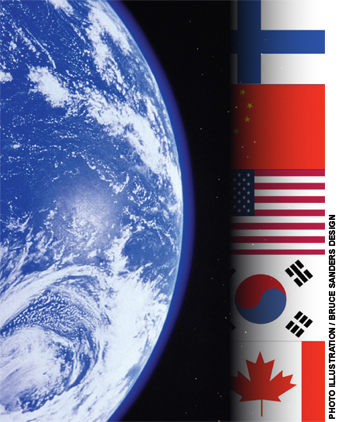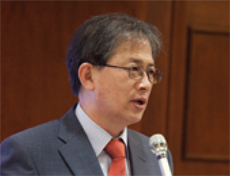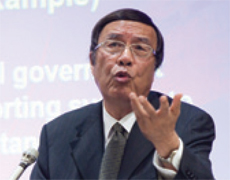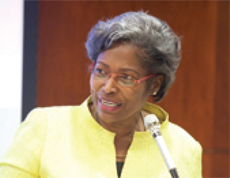 Undoubtedly, the United States has much to learn from education systems in other countries. Once the world’s education leader, the U.S. has seen the percentage of its high-school students who are proficient trail that of 31 other countries in math and 16 countries in reading, according to a recent study by Harvard’s Program on Education Policy and Governance (PEPG) (see “Are U.S. Students Ready to Compete?” features, Fall 2011). Whereas only 32 percent of U.S. 8th graders are proficient in math, 50 percent of Canadian students and nearly 60 percent of Korean and Finnish students perform at that level. It may be misleading to point out that 75 percent of Shanghai’s students are proficient, as that Chinese province is the nation’s most advanced, but in Massachusetts, the highest-achieving of the states, only 51 percent of the students are proficient in math.
Undoubtedly, the United States has much to learn from education systems in other countries. Once the world’s education leader, the U.S. has seen the percentage of its high-school students who are proficient trail that of 31 other countries in math and 16 countries in reading, according to a recent study by Harvard’s Program on Education Policy and Governance (PEPG) (see “Are U.S. Students Ready to Compete?” features, Fall 2011). Whereas only 32 percent of U.S. 8th graders are proficient in math, 50 percent of Canadian students and nearly 60 percent of Korean and Finnish students perform at that level. It may be misleading to point out that 75 percent of Shanghai’s students are proficient, as that Chinese province is the nation’s most advanced, but in Massachusetts, the highest-achieving of the states, only 51 percent of the students are proficient in math.
Given these performance disparities, it is only natural to think that there is something to be learned from practices elsewhere. Yet it is not easy to figure out what institutions and practices will translate into a different cultural milieu or how to do it. In the larger world of governmental constitutions, efforts to insert U.S. arrangements into distant political cultures have failed more often than not. Much the same could happen in reverse if the United States attempted to fix its schools simply by copying something that seems to work elsewhere.
It is tempting to undertake an in-depth study of those places that are performing at the highest levels—China’s Shanghai province, Korea, Finland, Singapore, Japan, the Netherlands, and Canada, for example. But a proper comparison requires that one contrast what successful countries do with the mistakes made by the less successful ones. International comparisons should look at information from all countries and adjust for factors that affect student performance, even though such rigorous studies typically face their own challenges, including collecting the requisite data. Moreover, countries are different across so many dimensions (from the political system to the cultural prestige of the teaching profession) that it is typically difficult to attribute differences between countries to any specific factors.
For these reasons, learning from international experience can be a bit like reading tea leaves: People are tempted to see in the patterns whatever they think they should see. But for all the hazards associated with drawing on international experience, the greatest risk lies in ignoring such information altogether. Steadfastly insisting that the United States is unique and that nothing is to be learned from other lands might appeal to those on the campaign trail. But it is a perilous course of action for those who wish to understand—and improve—the state of American education. If nothing else, reflection on international experience encourages one to think more carefully about practices and proposals at home. It is not so much specific answers that come from conversing with educators from around the world, as it is gaining some intellectual humility. Such conversations provide opportunities to learn the multiple ways in which common questions are posed and answered, and to consider how policies that have proved successful elsewhere might be adapted to the unique context of U.S. education.
That, perhaps, is the signal contribution of the August 2011 conference on “Learning from the International Experience,” sponsored by Harvard’s Program on Education Policy and Governance. Many who attended said the conference had sparked conversations well beyond the usual boundaries on thinking about U.S. education policy, whether the issue was teacher reforms, school choice, the development of common standards and school accountability, or the promise of learning online.
Need to Take Action

The conference opened with an urgent call from U.S. Deputy Secretary of Education Anthony Miller that action be taken. He highlighted two aspects of Harvard’s PEPG study in his remarks. First, by showing the dismal performance of students from families in which a parent has a college education, “the findings…debunk the myth that the mediocre performance of U.S. students on international tests is due simply to the presence of large numbers of disadvantaged students.” Indeed, the study shows that the percent proficient among U.S. students whose parents are college-educated or who are white is significantly less than the percent proficient among all students in countries such as Korea, Singapore, and Finland. Second, by breaking out results for every state, it shows that “the U.S. education system is comprised of 50 state systems, and therefore we must look at our performance on a state-by-state basis.”
Hoover Institution scholar Eric Hanushek built on Miller’s remarks by reporting that, according to work he did with University of Munich economist Ludger Woessmann, the United States could boost its annual GDP growth rate by more than 1 percentage point annually by raising student math performance to levels currently attained in countries such as Canada and Korea. That kind of increase in economic productivity could, over the long run, boost the U.S. economy by trillions of dollars. According to Hanushek, “the impact of the current recession on the economy is dwarfed” by the magnitude of the loss in wealth that has at its root subpar U.S. education performance.
Hanushek was careful to state that the goal was not to strengthen U.S. performance at the expense of other nations: The creation of well-educated citizens does not constitute a “a zero-sum game that countries or states are playing against each other,” but one in which every country and state can become more productive, and create more wealth for one another by boosting and sharing their talents. The United States can welcome the higher Canadian, Finnish, Korean, and Chinese performances even as those accomplishments make a compelling case for “changing the direction the United States is going.”
Further developing the case for reform, University of Arkansas scholars Jay P. Greene and Josh P. McGee (see “When the Best Is Mediocre,” features, page 34) provided conference participants with a glimpse of their new report, which identifies the international standing of nearly every school district in the United States. “People tend to think their own districts are OK,” even when the United States as a whole appears to be doing badly, Greene said. “But they really are not.” Even in expensive suburbs, student performance does not look very good from an international perspective, they said. “There is no refuge for ‘elite’ families in this country.” Greene and McGee reported that in 17 states they were unable to find a single district that performed at levels comparable to those reached by students in the world’s leading countries.
Teachers and Teaching

Offering hope that urgent action can be taken, Mona Mourshed told the conference that she and her colleagues at McKinsey & Company have shown that “systems can achieve significant gains in as short a time as six years.” Mediocre systems can become much better, and “those that are good can become great.” In her view, there are “clusters of interventions” that are appropriate for each stage of system development, and for each one, the key driver of change is teachers. The most important factor for every system’s journey of transformation, she said, is to develop teachers’ capabilities to their full potential. And others agreed. As New Jersey’s chief education officer Christopher Cerf put it, “The single greatest in-school variable driving [learning] outcomes is the quality of the teacher.”
But how can we ensure high-quality instruction? According to Mourshed, much depends on the stage a school system has reached. If a system is mediocre and has only low-performing teachers, then it can make the most progress through strong administrative actions that identify clear expectations for teachers and are fairly prescriptive. This may involve scripted teaching materials, monitoring of the time teachers devote to each task, and regular visits by master teachers or school inspectors. But, as the performance of the system rises and the teaching force reaches a higher level of quality, it can move “from good to great” by giving those teachers both greater autonomy and support. Among other things, great school systems decentralize pedagogical methods to schools and teachers, and put in place incentives for frontline educators to share innovative practices across schools. “Teacher teams” collaborate to push the quality and customization of classroom materials even further, and the educators rotate throughout the system, spreading peer learning and enriching mentorship opportunities.
Fernando Reimers of Harvard’s Graduate School of Education said that most teachers are trained in academic programs that have low prestige and are far removed from the activities of the classroom. Students in these programs are asked to think about sociological, psychological, and policy issues rather than to discuss what it takes to teach a particular lesson effectively. In this regard, schools of education are unlike other professional schools. He gave the example of business schools, which are increasingly asked to link instruction directly to the work future managers will be expected to do. Reimers urged that education-training programs combine mastery of the subject matter, needed especially today in math and science, with the ability to adapt teaching to different learners, to use technology effectively, and to enable project-based learning and teamwork.
In making these points, Reimers built on the presentation on Finnish training programs given by Jari Lavonen of the University of Helsinki. Advanced training at an education school in Finland is “more popular than medical school,” Lavonen told conference participants. Those admitted are a select group, and acceptance virtually guarantees a well-compensated and prestigious career. Rigorous training programs expect future teachers to demonstrate content knowledge in both a major and a minor subject, research competence, and classroom effectiveness. He admitted that the pedagogical research component was often contested by students (“we are teachers, not researchers”), but, he says, alumni later tell him that it was one of the most valuable parts of their educational experience. In his view, it is this component that enables them to tackle complex classrooms situations effectively later on. But, Lavonen cautioned, the system works in Finland only because the political situation was stable enough that the country was able to take “consistent decisions over the course of 40 years.”

Gwang-Jo Kim, former education vice-minister in Korea and current head of UNESCO in Thailand, also stressed the quality of those entering the teaching profession. Koreans are known for their “high regard for teachers and for the teaching profession.” Primary-school teacher-training programs receive many more applicants than there are spaces. There are multiple routes to certification as a secondary-school teacher, but the chances of getting a job are as low as 5 percent, as positions are avidly sought. Similarly, in Singapore, applicants to teacher-training programs are carefully selected, with a large proportion coming from the top 30 percent of the college population.
Kim said the Korean and Singapore success stories could not be understood apart from deep-seated cultural factors. The demand for teacher excellence comes from parents, who want their children to do well on national examinations that determine future education and occupational opportunities. As a result, teachers are under a lot of pressure. With unionization of the teaching profession in Korea, Kim wonders whether the current model can be sustained.
Building on these insights, White House education adviser Roberto Rodríguez reported that the Obama administration is developing models of teacher mentorship and induction that will support new recruits into the profession and renew teacher-preparation programs. “We don’t have a system that recruits talent. There is not a high bar for ed schools,” Rodríguez said. In addition, he emphasized the current lack of high-quality professional development for teachers and adequate mentorship for new teachers. Rodríguez confirmed the administration’s intention to create differentiated tracks for master teachers, administrators, and specialist teachers, in which teacher compensation is tied to progress on those tracks. Currently, he stated, “we lose too many good teachers to administration.” Underlining a point made by Deputy Secretary Miller, Rodríguez reminded the conference that, to be effective, change must come not only from the federal government but from “high levels of energy at the state and local level.”
Agreeing that state action is vital, New Jersey’s Christopher Cerf told conference participants that successful education systems do the same thing high-quality businesses strive to do: recruit from the very best, maximize the productivity of employees, evaluate responsibly and helpfully, deploy its workforce where it can be most helpful, and have a clear talent-retention strategy. But in the United States, he said, “We do all of these things badly in education. We recruit from whatever the ed schools give us, there is no productivity angle and no pay for results. We have taken the view that doing teacher evaluations is so hard that we should do nothing at all, and our retention strategy amounts to saying to high-performing teachers, ‘please stay.’” To change that system and lift the quality of the teaching force to international levels won’t be easy, cautioned Gerard Robinson, Florida’s chief education officer. “It is all about brute political force; the rest is a rounding error.”
Jason Glass, director of the Department of Education for the state of Iowa, reminded the audience that “we cannot take the challenges one at a time if they refuse to stay in line.” Glass said his priority is to alter the “one-minute interviews” used to make decisions on teacher hiring in too many school districts. He also seeks to improve the mentorship that teachers receive in their first year of teaching, which he says is virtually nonexistent in parts of his state. He plans to introduce more sophisticated systems that will identify—and retrain or remove—the state’s least-capable teachers. In reforming Iowa’s public school system, he intends to get beyond the prevalent false dichotomies, such as “cash for test scores versus step-and-lane compensation” and “due process versus random firing.” Performance measures able to identify the least capable teachers can and should be found. He concluded with a hopeful warning: “Watch out for Iowa over the next few years.”
Choice and Autonomy

Hindering the conversation on school choice was the fact that the mechanisms for choice in the United States do not resemble the choice mechanisms elsewhere. In the United States, private schools receive little government aid (except for transportation, lunch programs, and, in a few places, school vouchers), whereas in most other countries governments fund private schools at levels close to those for state-run schools. Charter schools are privately operated schools that are funded by the government, but they may not teach religion, while government-funded private schools in most other countries may do so.
Avis Glaze, former superintendent of the Ontario education system, correctly observed that Canada does not have charter schools, but others mentioned that the large number of religious schools that are both government-funded and subject to state regulation give Canadians even more choice than exists in the United States.
The conversation was also shaped by the recent release of a study by the Program for International Student Assessment (PISA), the same agency that collected the international data on which the PEPG report was based. According to the PISA study, international experience suggests that nothing is to be gained from expanding the private sector in education. Students in private schools do no better than students in public schools, once differences in family background characteristics are taken into account.
That finding, said Martin West, assistant professor at Harvard’s Graduate School of Education, is both misleading and, paradoxically, exactly what one should expect. When undertaking an international analysis of school choice, he argued, one should not compare the effectiveness of the public and private sectors but should instead look at the extent to which competition between the two sectors affects the achievement of all the students in the country, regardless of whether they go to public or private school. In countries such as high-achieving Netherlands, a large percentage of students attend private schools, with government paying the tuition. In countries such as low-performing Spain, only a few students attend private school. Other countries fall in between these two extremes. Using a sophisticated statistical technique, West showed that all students in a country learned more when the private sector was larger. Specifically, the study by West and his colleague found that an increase in the share of private school enrollment of 10 percentage points was associated with better than a quarter of a year’s worth of learning in math, though somewhat less in reading. Moreover, this increase in performance takes place within school systems that spend 6 percent less overall.
A degree of choice can be introduced in the state sector if decisionmaking is shifted to the school level, as has been done in Ontario, Glaze said. The U.S. Department of Education should provide support and oversight to local decisions and push specific “nonnegotiable” programs, such as the literacy program Ontario implemented in the 2000s. Paul Pastorek, Louisiana’s former chief education officer, agreed that the Ontario experiment had been successful but said the United States needed a different approach. The story of school reform has too often been one of a strong district or state leader driving reform until the end of her tenure, with stagnation afterward. Only the powers of competition embedded within a system can lead to sustained improvements. “The problem is that we don’t know how to leverage competitive forces in the multibillion-dollar business that is education in this country,” said Pastorek. “Our education system is a communist system; we don’t have anything that relates what we pay for resources to the economic value they generate.”
The introduction of competition in New Orleans, where 85 percent of the schools are now charter schools, said Pastorek, provided a foundation for continued reform and improvement. But choice works only if choice systems are equitable, schools are held accountable by the state or school district, and parents are given readily understandable information about school quality. In the view of many, a great system would be one in which through the power of competitive forces, as Pastorek described, states create a system that “self-corrects, self-challenges, and self-innovates” to achieve better results for children.
State Standards and Accountability

Common standards and tests that evaluate performance against those standards are to be found in most of the countries that are performing better than the United States, whether they be in Europe or Asia. Shengchang Tang, principal of the Shanghai High School (the leading high school in China), said that the standards and examinations in the Shanghai province are a powerful tool that parents use to exert pressure on their children as well as on teachers and principals. (These particular standards and exams do not extend to the whole of China, which is deemed too large to have a single set of exams.) In his view, that pressure focuses attention in schools and fuels the drivers of the successful Shanghai education system, including higher investments, a high-caliber teaching force, and a strategy tailored to the specific situation faced by each school.
Tang questioned whether common standards would be effective in the very different U.S. context. Specifically, he was skeptical that such standards would catalyze more effective parent pressure on U.S. schools, given parents’ comparatively low expectations of their children and their schools. In contrast, in a recent poll in Shanghai, 85 percent of parents declared that they expected their children to be in the top 15 percent of their age cohort. Standardized exams, in Tang’s view, serve as a necessary tool to measure reality against these high expectations. For Angus MacBeath, former school commissioner in Edmonton, Alberta, Canada, however, setting high standards in his home province allowed him to “tell the ugly truth,” and it was the necessary first step toward Alberta’s journey of educational improvement. Common standards allow parents, educators, and policymakers to be clear about current achievement levels so they can act on that knowledge.
This is perhaps the reason the Obama administration has lent its support to the Common Core State Standards Initiative, which has been embraced as a reform solution by 44 states and the District of Columbia. Still, many wondered with James Stergios of the Pioneer Institute in Boston whether one can set standards capable of driving high performance nationwide in a country that has great regional disparities in student achievement and a decentralized governmental system (where schools are “radically local,” as one panelist put it). Declaring himself “a massive opponent of common standards,” Stergios argued that the excellence achieved by Massachusetts so far could not be sustained if nationwide standards were substituted for state ones.
Gerard Robinson began his comments by acknowledging that he was chief education officer in Virginia while that state was opposed to common standards and is now chief in Florida, which is committed to common standards. He offered two reasons for embracing common standards: 1) students must compete with those in other states and, indeed, with students all over the world, and 2) companies need common standards in order to compare job applicants. “The difficult part is not to have consensus on having common standards,” he observed, “but on how to work on the political process to achieve them.”
In the end, the standards issue seemed to turn on the questions raised by Shanghai’s Shengchang Tang. Could the United States create common standards that were high enough to spur high achievement? While “having high state standards makes a big difference to underprivileged people,” as Christopher Cerf put it, common standards might be set too low and so, contrary to what the PEPG report showed, may not serve to raise standards of achievement when U.S. students are compared to their peers in high-achieving countries. He reminded the group that the same political context exists today as existed when No Child Left Behind was crafted. As prescribed in that legislation, every child was supposed to be proficient, but to comply with federal expectations many states “dumbed down” their definition of student proficiency.
Digital Learning

In her opening remarks for the panel on digital learning, New Mexico’s chief education officer Hanna Skandera stressed that the new technologies provided new opportunities to address together all the reforms under discussion. Digital learning that exploits online courses and broadband capabilities can expand choice for students, ensure transparency and accountability for courses offered online, and create opportunities for many more students to come into contact with the very best teachers. Further, it can serve as a catalyst for higher standards and can do all this without driving up the cost of education.
Shantanu Prakash, of Educomp Solutions, informed the audience about the business he started and now heads in India. Educomp serves more than 12 million students in India alone and operates in a number of other developing countries where traditional schools have limited resources and set low standards for instruction. Educomp targets schools with products it says are not only inexpensive but user-friendly and easily combined with traditional classroom instruction. “The whiteboard can be used with millions of modules that are very good, that will support any teacher,” he noted. Prakesh expects the demand for his products to grow rapidly, as “the pressure of parents will make the introduction of digital materials into the learning of children in a meaningful way inevitable.” It is an obvious means for parents with high expectations all over India to ensure that their children receive high-quality instruction, in a context of scarce resources and low teaching standards.
Susan Patrick, president and CEO of the International Association for K–12 Online Learning (iNACOL), agreed: “Education is no longer a cottage and local industry,” but one in which true competition can thrive, improving standards and driving productivity gains. Digital learning can give students greater choice, even down to the specific instructor for a particular course. Digital learning is a growing reality in many other countries. Citing numerous references, Patrick told of its widespread adoption across the world. In Singapore, for example, all schools blend online learning with classroom instruction, and the country’s schools of education have made online instructional techniques an integral part of the curriculum. South Korea is once again a leader, and virtual education has become a rapidly growing industry, partly to reduce the cost to parents of the “cram schools” that families expect their adolescent children to attend.
Also participating in the conference was Julie Young, president and CEO of the Florida Virtual School (FLVS), the leading example of digital learning in the United States. Since its beginnings in 1996, FLVS has grown steadily and currently has nearly 200,000 course enrollments. The reasons for its success, according to Young, include student access to teachers seven days a week and beyond the regular school day, choice in assignments, and a constantly improving curriculum and instruction that is transparent to administrators, parents, and outsiders.
The main barrier to the spread of digital learning in the United States, iNACOL’s Patrick noted, are “policies that were created 30 to 40 years ago for a different world. Digital teachers cannot easily be qualified in multiple states, funding follows student and sometimes physical attendance, and there are no common standards across states that would reduce the costs of development.” Only when those policies are upgraded purposefully to accommodate and encourage a different kind of classroom environment will digital learning become an integral part of the American education system.
Tea Leaves or Tea?

So what did the conference brew? No one can make the case that the conference provided secret bullets for school reform in the United States, and most every conference participant would agree that the particulars of the United States make it difficult to introduce wholesale many of the practices that have been successful abroad. Popular culture shows little appreciation for the educated citizen; a decentralized government arrangement with multiple veto points precludes rapid innovation; and education politics is marked by antipathy between teachers unions and school reformers. But a nuanced assessment of the conversation allows for at least preliminary conclusions that go beyond a simple call for urgent action:
• Teacher selection, teacher training, teacher evaluation, and teacher retention in the United States can be done much better than it is being done today. While no country has exactly the right model for the United States, none of the successful systems leave good teaching simply to chance the way the United States does.
• School choice plays a bigger—and perhaps more successful—role in the world’s educational experience than is usually recognized. It should not be seen as a threat but rather as an incentive for improvement for the public education system.
• Standards and testing systems that hold students accountable for their performance are part and parcel of most, if not all, of the world’s top education systems. If the United States has a heterogeneity that precludes the adoption of a uniform examination system as those found in Korea, Singapore, and in many parts of Canada, that provides no reason not to set clearer, and higher, expectations for students than is commonly the case.
• Digital learning has yet to prove itself fully and to develop into an integrated paradigm-shifting approach, but early stories of success are promising, provided digital learning respects the principles of transparency, accountability, and choice for students.
More than reaching any specific conclusion, the conference was most successful in inspiring participants with a renewed understanding of and dedication to their common commitment to a better system of education. The commitment is now informed by the experience of other countries with similar challenges that have managed, through sustained and consistent policies (as the Finnish representative, Jari Lavonen, insisted) to find solutions.
Carlos X. Lastra-Anadón is a research fellow at the Program on Education Policy and Governance. Paul E. Peterson is director of the Program on Education Policy and Governance at Harvard University and senior fellow at the Hoover Institution.
This article appeared in the Winter 2012 issue of Education Next. Suggested citation format:
Lastra-Anadón, C.X., and Peterson, P.E. (2012). The International Experience: What U.S. schools can and cannot learn from other countries. Education Next, 12(1), 52-59.


